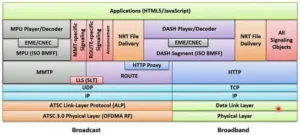The Advanced Television Systems Committee (ATSC) has standardised three more components of the next-generation television system that it hopes will transform the ability of broadcasters to deliver mobile, interactivity and higher quality content.
ATSC members have ratified the Link Layer Protocol and Audio and Video Watermark Emission standards to be part of the ATSC 3.0 suite of 20 standards and recommended practices. At the same time, three new Proposed Standards and two new Candidate Standards are moving forward within the technical subcommittee charged with developing and documenting ATSC 3.0.
“These are each important elements that will give ATSC 3.0 remarkable flexibility. The three new standards join two others (the A/322 Physical Layer and A/321 System Discovery and Signaling standards) already approved by ATSC members. Other parts of ATSC 3.0 are rapidly moving through the standardization process,” said ATSC President Mark Richer.
Technical details on the three newest ATSC 3.0 standards:
The Link Layer Protocol Standard (A/330) defines the layer between the physical layer and the network layer. The link layer transports the data from the network layer to the physical layer at the sending side and transports the data from the physical layer to the network layer at the receiving side. The ATSC Link-Layer Protocol also optimizes the proportion of useful data in the ATSC 3.0 Physical Layer, by means of efficient encapsulation and overhead reduction mechanisms for IP and MPEG-2 TS transport. Extensible “headroom” for future use is also provided.
The Audio Watermark Emission Standard (A/334) specifies the audio watermark encoding for use with systems conforming to the ATSC 3.0 family of specifications. This standard specifies the format in which the audio watermark resides in an uncompressed audio signal.
The Video Watermark Emission Standard (A/335) specifies the emission format for video watermarks used in ATSC 3.0 broadcasts. The video watermark technology provides the capability to robustly embed ancillary data in the transmitted pixels of a video signal. It provides a data path for its ancillary data payload that can readily survive changes in video compression data rate, transcoding to other video compression codecs, and delivery over legacy consumer HDMI interfaces.
This week, ATSC Technology Group 3 (TG3) members have begun voting to elevate three ATSC Candidate Standards to Proposed Standard status (the final step before ATSC member approval):
- A/322 Service Announcement, which defines announcement of services in an ATSC 3.0 broadcast;
- A/333 Service Usage Reporting, which defines service usage reporting for ATSC 3.0; and
- A/343 Captions and Subtitles, which defines the required technology for closed caption and subtitle tracks over ROUTE-DASH and MPEG Media Transport.
TG3 members also are voting to elevate the A/360 Security draft document to Candidate Standard status. A/360 specifies the mechanisms for security and service protections in ATSC 3.0 systems. The A/324 Scheduler and Studio-to-Transmitter Link is now a Candidate Standard. Among other things, it specifies the interface protocol and operation parameters for Single Frequency Network transmitters.

